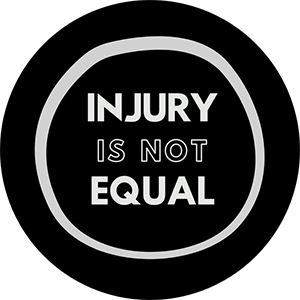Inequity in injury

Around the world, more than 5 million people die each year as result of injury (1). It is the leading cause of death for Canadians under the age of 35 years, and a leading cause of hospitalization and death for all ages (2). Injury is not experienced equally across the population (3). Like other health issues, injury risk is affected by the social determinants of health. Here are examples:
Income & income distribution: people living in the lowest income areas are 1.4 times more likely to die from unintentional injury than the highest income area (4).
Employment & working conditions: being new to work is a driving factor in workplace injury. Young workers, precariously employed workers new to their position, and recent immigrants are more likely than experienced workers to be injured (5).
Education: there is an inverse relationship between unintentional injury rate and education status. Areas with lower education status have higher rates of unintentional injury than people living in areas of high educational status (4). Completing post-secondary education is associated with lower risk of injury (6).
Housing: the home environment is a primary indicator for unintentional injuries in children in low income neighborhoods. Causes of house related injuries include structural conditions to substandard housing, lack of safety equipment, low income and material deprivation (6).
Sex and gender identity: while boys and men are more likely to die from injury (7), there is need to understand the type, frequency and severity of injury experienced across the spectrum of sex and gender. Females aged 15 years and older are more frequently victims of violent crime than their male counterparts (8). Intimate partner violence is nearly four times higher for women. Approximately half of female victims of intimate partner violence suffered some type of injury (8). Data from the Homicide Survey indicates that Aboriginal women are disproportionally represented as homicide victims. Similarly, victimization data indicate that Aboriginal women have higher rates of self-reported spousal and non-spousal violence (8). LGBTQ+ people are targets of sexual and physical assault, harassment and hate crimes (9). An Ontario study of trans people found 20% of participants experienced physical or sexual assault due to their identity (9). Trans people in Canada and US report high levels of violence, harassment and discrimination when looking for employment, stable housing, social and health services (9).
Urban & rural environments: rural injuries are more likely to involve multiple injuries and crush injuries. Injuries in rural areas tend to be more severe with a higher likelihood of hospital admission, and more likely to be due to motor vehicle collision involving all-terrain vehicles (ATV) and snowmobiles (10). By comparison to urban counterparts, rural individuals who are injured are more likely to have lower levels of formal education, have skilled-labour occupations and have a diagnosed comorbidity (10).
Race: there is a disparity in rates of injury between aboriginal and non-aboriginal populations (11). Injury hospitalization rates were highest in geographic areas with percentage of individuals who identify as first nations, Metis and Inuit (11). Racialized communities experience an increased risk of injury: racialized individuals are usually employed in under-regulated jobs, work long hours, experience high stress and are paid low wages (6).
Age: injuries are experienced differently across the lifespan. Global estimates suggest that over 630,000 children under age 15 are killed by an injury (1). A large proportion of injuries to children happen in or around the home (1). According to a health survey, 40% of Canadian children sustain an injury needing some form of medical treatment (6). More than 4 million Canadians aged 12+ suffer an injury severe enough to limit usual activities (12). Adolescents (aged 12-19 years) are two times more likely than other age groups to experience injury (12). Everyday activities like household chores and walking account for over half of senior injuries (12). Falls cause 85% of senior’s injury-related hospitalization, 95% of all hip fractures, $2 billion a year in direct healthcare costs (13). As a result, over one third of seniors are admitted to long-term care falling hospitalization for a fall (13). In 2017-18, over half of all injury-related hospitalizations in Canada were for seniors 65 years and older (14)
Because injury is not equally experienced in our community, The Centre for Injury Prevention strives for just and equitable programming to address these inequities.
We do this by:
- Using a public health framework to address underlying factors of injury risk
- Improving program access to people most vulnerable to injury
- Participant-centred programing that promotes the student as teacher
- Community collaboration to develop programs/events in partnership
- Train-the-Trainer model to empower community leadership in injury prevention
- Hospital-based violence intervention to connect at-risk patients to community resources
- Creator of podcast Injury is Not Equal
References
- World Health Organization. Injuries and Violence: The Facts [Internet]. 2014 [cited 2020 Jun 28]. Available from: www.who.int/healthinfo/global_burden_disease/projections/en/
- The Cost of Injury In Canada. Toronto; 2015 Sep.
- Atlantic Collaborative on Injury Prevention. The Social Determinants of Injury. 2011.
- Public Health Agency of Canada. Key Health Inequalities in Canada - A National Portait. 2018.
- IWH early research on vulnerable workers [Internet]. [cited 2020 Jun 28]. Available from: www.iwh.on.ca
- Pike I, Richmond S, Rothman L, Macpherson A. Canadian Injury Prevention Resource An evidence-informed guide to injury prevention in Canada. 2015.
- Sorenson SB. Gender disparities in injury mortality: Consistent, persistent, and larger than you’d think. American Journal of Public Health [Internet]. 2011 Dec 1 [cited 2020 Jun 28];101(SUPPL. 1):S353. Available from: /pmc/articles/PMC3222499/?report=abstract
- Maire Sinha. Measuring violence against women: Statistical trends. 2013 [cited 2020 Jun 28]; Available from: www.statcan.gc.ca
- Lesbian, Gay, Bisexual, Trans & Queer identified People and Mental Health [Internet]. [cited 2020 Jun 28]. Available from: ontario.cmha.ca/documents/lesbian-gay-bisexual-trans-queer-identified-people-and-mental-health/
- Mcfaull S, Bang F, Cheesman J, Do MT. The rural-urban gap: differences in injury characteristics. Health Promotion and Chronic Disease Prevention in Canada Research, Policy and Pratice [Internet]. 2019 [cited 2020 Jun 28];39(12):317–22. Available from: doi.org/10.24095/hpcdp.39.12.01
- Brussoni M, George MA, Jin A, Lalonde CE, McCormick R. Injuries to Aboriginal populations living on- and off-reserve in metropolitan and non-metropolitan areas in British Columbia, Canada: Incidence and trends, 1986-2010. BMC Public Health [Internet]. 2016 Dec 13 [cited 2020 Jun 28];16(1):397. Available from: bmcpublichealth.biomedcentral.com/articles/10.1186/s12889-016-3078-x
- Injuries in Canada: Insights from the Canadian Community Health Survey [Internet]. [cited 2020 Jun 28]. Available from: www150.statcan.gc.ca/n1/pub/82-624-x/2011001/article/11506-eng.htm
- Seniors’ Falls in Canada - Infographic - Canada.ca [Internet]. [cited 2020 Jun 28]. Available from: www.canada.ca/en/public-health/services/health-promotion/aging-seniors/publications/publications-general-public/seniors-falls-canada-second-report/seniors-falls-canada-infographic.html
- Canadian Institute for Health Information. Injuries among seniors | CIHI [Internet]. 2019 [cited 2020 Jun 28]. Available from: www.cihi.ca/en/injuries-among-seniors







